Timeline illuminating the minor cinemas of Oregon, 1910-1965
What role did the minor cinemas (newsreels, educational films, industrial films, experimental films, animation, home movies) play in Oregon’s overall film history?
I drew up this timeline for Sheldon Renan, noting the early appearance of our regional specialty, the independent writer-director-producer.
I italicize figures whose entire careers take place outside the state lines. Some people don’t consider these artists part of Oregon film history. I do.
Three time Oscar nominee James Ivory made fourteen low budget independent features before his first Oscar nomination, for ROOM WITH A VIEW, in 1987.
Part One: 1910-1928, Silent Oregon
William L. Finley (1876-1953), Oregon’s first nationally distributed independent writer-director-producer, made nature themed newsreels. His name carried enough weight so that it appeared in endorsements for home movie cameras in national print advertising campaigns. His filmmaking was mission driven – he was an ornithologist and conservationist. Finley doesn’t wear his filmmaker hat in Larry Lipin’s OHQ article about his good roads advocacy.
Jesse Sill (1881-1981), Portland based filmmaker specializing in local and national newsreels. He used the business model (later adopted by Lew Cook and Norm Dimick), of offering both filmmaking and film processing services. In addition to shooting regional events for national newsreels, Sill created an entirely local newsreel series for local movie theater audiences, the Webfoot Weekly. He was active in both the silent era and the sound era, eventually working as a cameraman for Portland television news stations. Amos Burg (1901-1986), was taught by him. Walt Dimick, Ron Finne, Gary Lacher all knew him. Ellen Thomas’ masters thesis, Commercial Motion Picture Production in Portland Oregon, 1910-1928, discusses him.
Lewis Moomaw (1889-1980), writer-director-producer. One of the founders of American Lifeograph, a full scale film studio which opened in 1910 on SE Yamhill. Directed several Portland based live action feature length films. THE CHECHACOS (1924), shot on location in Alaska, has been restored and preserved. His last feature film in Portland, FLAMES (1926), was written by Alfred Cohn, who the following year was Oscar nominated for his screenplay for THE JAZZ SINGER. Eugene O’Brien, a big star, was the leading man in FLAMES; Jean Hersholt and Boris Karloff in supporting roles. The coming of sound moved Moomaw to Hollywood, not sure what he did there.
Pinto Colvig (1892-1967), writer-director-producer. Born and raised in Southern Oregon, educated by a combination of Oregon Agricultural College and the circus, Pinto began animating in San Francisco. Some film historians list his lost film, CREATION (1916), as the first animated feature. Moving to LA, he did animated special effects for silent film, and then, with the coming of sound, the voice work which made him famous.
Lew Cook (1909-1983) was trained by Jesse Sill to shoot newsreels while still in high school. He worked for Sill, then went out on his own. He made THE LITTLE BAKER, a stop motion animated short, in the 1920s. Spent most of his career in Portland, with the exception of his WWII years, and some post-WWII years, in the military. Founder of OHS Moving Image Archive, he selected and trained his successor, Michele Kribs. He mentored Homer Groening and Jim Blashfield, who later paid tribute to him in a ten minute profile for OPB.
Every one of these filmmakers made work which was seen nationally. Not a farm team. When film was brand new, Hollywood did not yet have the monopoly on content.
Part Two: 1929-1965, Sound Era Oregon
The regionally made independent feature disappeared with the coming of sound. Too expensive! On the smaller screens, home movies thrived, as did films made for classrooms, sales conventions, and grange halls.
Figures whose careers took place entirely outside the state are italicized.
Luther Cressman (1897-1994) used film to document archeological field work. Arriving at UO in 1930 as a sociologist, by 1939 he was making films as an archeologist. In Bali, at the exact same time, his ex-wife Margaret Mead was doing the same thing.
Lester Beck (1908-1977) used film to document UO psychology experiments, then started writing and “supervising” (does this mean directing? producing?) educational films. After HUMAN GROWTH (1947), a nationwide sex education hit, Beck became head of USC’s film department. USC film student James Ivory remembers fulminating against Beck’s emphasis on short, non fiction filmmaking. Beck left USC to teach psychology at Portland State College in 1955. He brought one of his USC faculty, Andries Deinum, future founder of PSU’s Center For The Moving Image,with him. Beck continued making educational films throughout the 1960s. From Malheur County.
Stephen B. Kahn (1910-2007) combined the journalism he studied at UO and the law he studied at University of Tennessee as a PR man for Bonneville Power Administration. He hired Woody Guthrie to compose songs for THE COLUMBIA (recorded in 1941, film completed in 1949). Raised on radical politics in Manhattan’s Lower East Side, Kahn’s last chapter of life was spent as a lumber man and philanthropist in Northern California.
Norm Dimick (1910-1991) began making films while still in high school (as did Lew Cook, his near exact Portland contemporary.) Taking a page from the long career of Jesse Sill, Dimick Motion Picture Services on NE Sandy offered production, post production, and film processing services. The stability of Dimick’s diversified business model meant he was around to provide crucial assists to the re-emergence of independent film in sound era Portland. Viewmaster used his lab to process their film in the 1940s; brand new filmmaker Homer Groening hired Dimick for sound editing in the late 1950s; young Berkeley undergraduate Will Vinton came by for advice (and parts) crucial to an aspiring stop motion animator in the 1960s.
Frank Hood (1912-1987) made training films and sales films for a brand new start up named Tektronix in the mid-1950s. He left Tektronix to found Teknifilm, a processing lab, in 1964. In Hood, we see the flicker of a return of the writer-director. When Hood moved Teknifilm into Portland’s Film Row buildings on NW 19th, he was bridging Portland’s silent and sound eras. His lenient approach to payment schedules made loyal customers of many Portland independent filmmakers, who located their studios nearby.
Andries Deinum (1918-1995), writer-director-producer. Blacklisted in Hollywood, Deinum arrived in Portland in 1957, and opened PSU’s Center For The Moving Image, the first film school in the PNW, in 1969. His students included Brooke Jacobson and Bob Summers, who co-founded Northwest Film Center in 1971, music video pioneer Jim Blashfield, cinematographer Harry Dawson, and historian Michael Munk. Oregon Encyclopedia notes: “Deinum’s innovative television series Urban Mosaic, begun in 1965, offered “weekly scrutinies of our immediate environment and its impact on human values.” The mosaic consisted of discussions, confrontations, filmed reports and interviews assembled each week within a flexible time slot. He made the show a place where Portland’s officials, architects, realtors, and diverse citizens might encounter one another.” Deinum was invited to Portland by Lester Beck, his former boss at USC. Heather Petrocelli’s masters thesis, Portland’s “Refugee from Occupied Hollywood”: Andries Deinum, his Center for the Moving Image, and Film Education in the United States, examines his PSU years.
Homer Groening (1919-1996) writer-director-producer. Exposed to filmmaking as an account executive at Botsford Constantine & Gardner, Groening struck out on his own in 1958, taking the Jantzen account with him. As Homer Groening, Inc., he made commercials, documentaries, industrial films, promotional films, and experimental short films. His merging of business success and artistic independence inspired the independent filmmakers who followed him: Will Vinton, Bill Plympton, Matt Groening.
Harry Smith (1923 -1991), writer-director-producer. Born in Portland, raised in Bellingham & Anacortes. Experimental animator, music ethnologist, anthropologist. The second generation black sheep scion of a powerful salmon canning family, he was a disciple of Franz Boas, as was Luther Cressman. Too important to leave out of Oregon film history, so I always include him. Wildly influential.
John Parker Jr (1925-1981), writer-director-producer. The son and heir of a Portland theater chain mogul, Parker made Oregon’s first sound era independent feature, DEMENTIA (1953), in Los Angeles. Highly stylized, low budget, black & white, with a score by George Antheil, Parker’s first and only film was made for a hybrid art house/exploitation audience no one else dreamed existed.
James Ivory (b. 1928), writer-director-producer. Oregon’s most distinguished filmmaker. A titan in the history of independent film. Not often seen that way, because Hollywood distributed his (resolutely independent) films. Founded Merchant Ivory Productions in 1961. His decades long collaboration with producer Ismail Merchant and screenwriter Ruth Prawer Jhabvala began with THE HOUSEHOLDER (1963), shot in Delhi. Ivory received Oscar nominations for ROOM WITH A VIEW (1987), HOWARD’S END (1993), and REMAINS OF THE DAY (1994). He graduated from Klamath Union High School in 1946 and UO (art history) in 1951. Classmate of James Blue.
James Blue (1930-1980), writer-director-producer. Oregon’s first Oscar nominated filmmaker began making films at age 12. Like James Ivory, his career breakthrough happened overseas. THE OLIVE TREES OF JUSTICE (1962), shot in Algeria, was good preparation for the cultural and political complexities of THE MARCH (1963), shot on the Washington Mall. After the Oscar nomination of A FEW NOTES ON OUR FOOD PROBLEM (1969), Blue spent the last decade of his life teaching, making experimental documentaries, and advocating on a national level for regional film. He graduated from Jefferson High School in 1949 and UO (theater) in 1953. Classmate of James Ivory.
Ken Kesey (1935-2001), writer-director-producer. Kesey’s home movies of his 1964 cross country bus trip were made during a time experimental filmmakers were pushing the boundaries of the medium. He continued to edit and re-edit the 1964 footage throughout his life, while continuing to document his live shows on film/video. I believe it is fair to describe Kesey as an experimental filmmaker. Paul Newman and Milos Forman adapted Kesey’s region-centric novels into feature films, but Kesey’s interests lay elsewhere – in film as a happening. I classify this part of his career as underestimated and misunderstood, perhaps even by himself. Graduated from Springfield High School in 1953, UO (speech & communication) in 1957.
I will pick up the timeline as it continues into the 1970s, when independent filmmaking returns to Portland.
Sources:
I learned about Jesse Sill from Ellen Thomas, UO masters thesis; Pinto Colvig from Ben Truwe (2015 OFHC); Lew Cook from Michele Kribs; Lester Beck from Elizabeth Peterson (2017 OFHC) & Michael Aronson; Stephen B. Kahn from Libby Burke (2016 OFHC); Norm Dimick from Walt Dimick (2015 OFHC); Frank Hood from Robert Zurcher; Andries Deinum from Brooke Jacobson (2015 OFHC) and Heather Petrocelli, PSU masters thesis; Homer Groening from Lisa Groening & Matt Groening (OCI Mid Century Oregon Genius); Harry Smith from Sheldon Renan (OCI Harry Smith PDX, 2015 OFHC); John Parker Jr. from JD Chandler and Joshua Fisher; James Ivory from James Ivory (OCI Mid Century Oregon Genius); James Blue from Richard Blue (OCI Mid Century Oregon Genius, 2016 OFHC).











